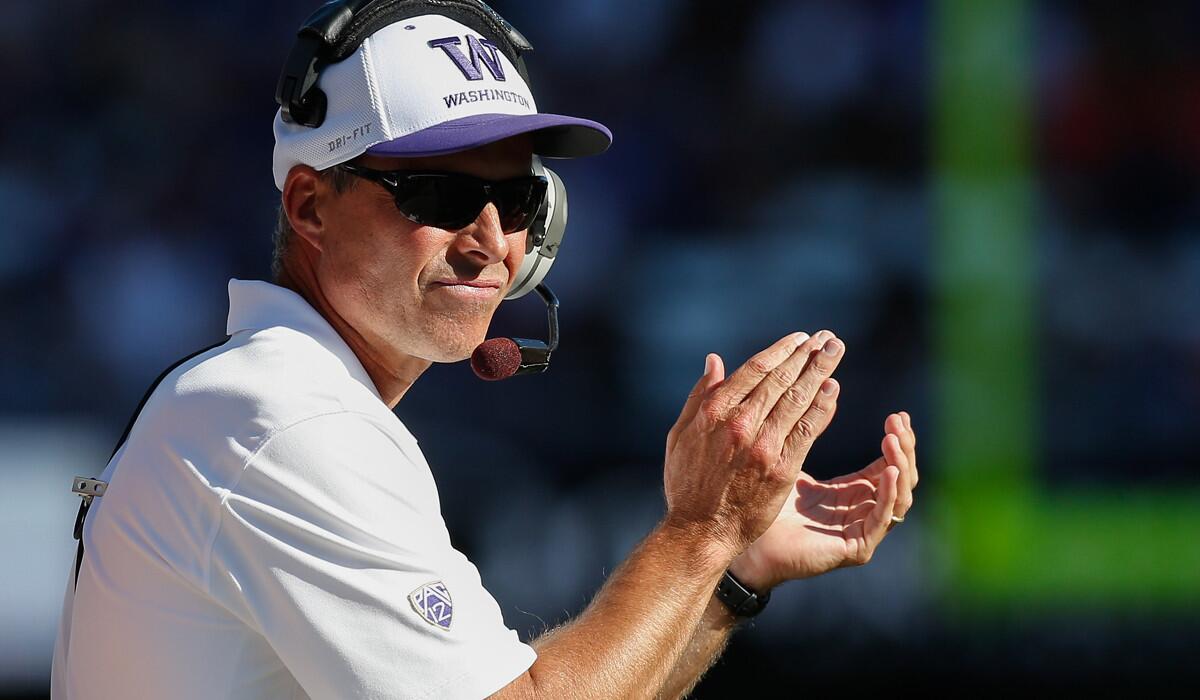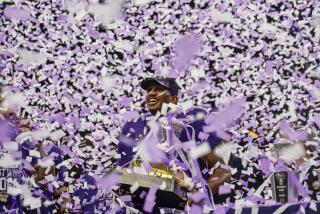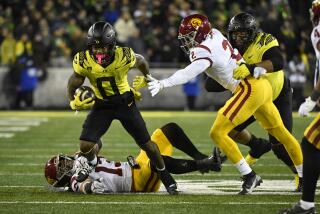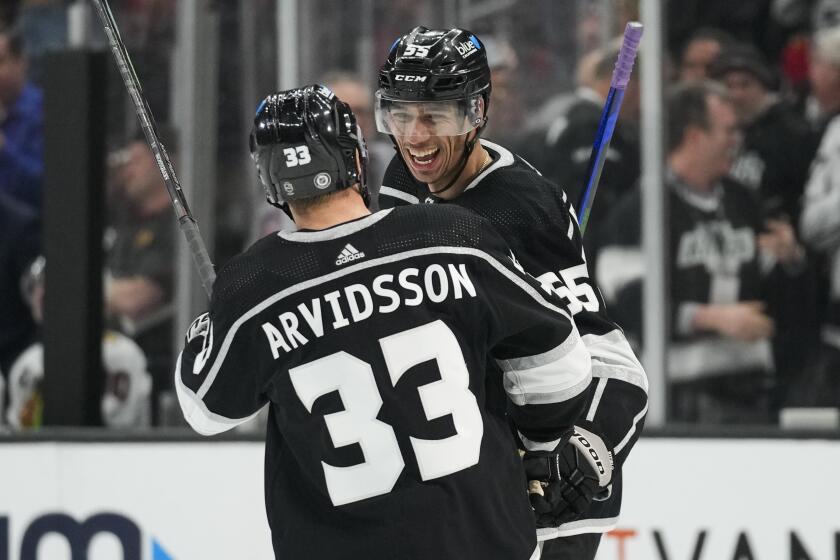Column: Pac-12 Conference is getting to be a tougher neighborhood

Chris Petersen will face his old team, Boise State, for the first time in 2015.
The talk this summer was that Pac-12 Conference football was as strong as anyone with a memory could remember it.
“Those are statements usually made prior to the season, where everyone kind of has that overall, positive look,” Oregon State Coach Mike Riley said this week, meaning words don’t mean much.
After one month, here is where the statements stand:
The Pac-12 top isn’t as strong as advertised. Oregon and UCLA, picked to win the North and South divisions, have not lived up to preseason top-10 billing. Oregon has been decimated by offensive line injuries and is subsisting off quarterback Marcus Mariota, America’s best player.
UCLA underperformed in victories against Virginia, Memphis and Texas but enters the Pac-12 fray still playing for everything on its wish list.
Stanford, the two-time defending league champion, is formidably flawed. The Cardinal has pitched shutouts against UC Davis and Army but lost at home to USC, which lost at unranked Boston College.
Arizona State, which won the South Division last year, is playing hurt while it awaits the return of star quarterback Taylor Kelly.
The Pac-12 bottom, overall, is stronger.
Washington State, the only Pac-12 team with a losing record, gave Oregon its toughest game and only a fumbled punt cost the Cougars a win against Rutgers.
With Connor Halliday at quarterback, Washington State will continue to be a pain. Last week, Halliday needle-threaded two scoring throws behind the helmet hole of Oregon’s Ifo Ekpre-Olomu, the Pac-12’s best cornerback.
Utah, 9-18 in its first three years of Pac-12 play, appears to have overcome its brutal entry fee. The Utes are 3-0 and coming off a big win at Michigan.
Colorado and California, maybe the worst teams in major college play last year, are significantly improved.
Last year, Colorado’s home win over Cal was its only win in Pac-12 play. Cal finished 0-9 and 1-11 overall.
This weekend, Cal hosts Colorado in a “See How Far We’ve Come” rematch in Berkeley. Cal has already won at Northwestern and thought it had defeated Arizona on Saturday before blowing a 31-13 fourth-quarter lead.
The Pac-12’s edges have coalesced into a meaty, mighty middle section.
The league went 29-4 in nonconference play and boasts seven of the 25 remaining undefeated schools.
The SEC West is the best division in college football, but the Pac-12 is a better league from bottom to top.
The SEC East has struggled. Kentucky hasn’t won a league game since 2011, Vanderbilt has already lost to Temple, and “much improved” Tennessee got exposed at Oklahoma. Florida allowed a school-record 645 yards to Alabama last week. Missouri, the defending East champions, lost at home to Indiana, and South Carolina last week barely escaped at Vanderbilt.
“We’ve all seen good football teams,” South Carolina Coach Steve Spurrier said after his team’s 48-34 win. “We ain’t one.”
Yet South Carolina did manage to defeat Georgia, maybe the best team the East has to offer.
The Pac-12 has nine schools ranked in the top 40 of this week’s Associated Press poll. The 14-team SEC has seven schools ranked in the top 14, but five are from the West.
The Pac-12 moves to the heart of league play this week with confidence and momentum.
Six quarterbacks rank among the top 14 in NCAA passing efficiency. Oregon State leads the nation in pass efficiency defense and Oregon leads in pass efficiency offense. Stanford is tops in total defense, scoring defense and pass defense while Washington leads the nation in sacks.
September, though, was the easy part. The same Pac-12 coaches that spent the summer peddling their league now face the consequences.
The bloodletting begins with UCLA at Arizona State, Stanford at Washington, Washington State at Utah, Oregon State at USC and Colorado at Cal.
Oregon and Arizona have the weekend off as they prepare for Oct. 2’s game in Eugene.
Welcome to the Packed-12.
Oregon State is 4-0 and may have its best defense in years. Washington hasn’t looked all that great, yet Chris Petersen is the first Washington coach to begin his Huskies career 4-0 since 1908.
Pac-12 coaches have gone from pride in their hearts to hearts in their throats.
“I would rather everyone we play not be good,” Arizona Coach Rich Rodriguez joked this week. “Let’s be honest. I don’t like these tough games. I’d rather be really good in a crappy league, but it’s not going to happen. That ship has sailed.”
Coaches are worried that parity comes with a price.
Stanford Coach David Shaw was more discomfited than entertained after watching Arizona’s wild, Hail Mary win over Cal.
“Every game is scary,” he said. “No one had a lot of expectations for Cal, and there were moderate expectations for Arizona. And then you turn their game on and you say, ‘Wow.’”
What toll will the league race have on Pac-12 playoff chances?
“That’s what we don’t know,” Shaw said. “To me, that’s the biggest unknown. It all hinges, as we all know, on the committee. Imagine a two-loss Pac-12 champion that played a hellacious schedule. Do they get bumped for a one-loss or undefeated team that did not play the same type of schedule? That to me is going to determine where this playoff goes.”
Shaw said if the Pac-12 gets shafted he will lead a march on conference headquarters in downtown San Francisco.
“I can guarantee you there will be 12 coaches going to the commissioner and saying, ‘Hey, we need to change our schedule. If we’re going to beat each other up and get left out, we need to do what everybody else is doing, schedule-wise, or at least what some other people are doing schedule-wise.”
That last comment seemed a veiled shot at the SEC, which opted to stay with an eight-game league format in a 14-team conference (the 12-team Pac plays nine league games).
Shaw is willing to see how it all plays out. He says if the committee rewards the Pac-12, “that justifies what we do.”
From now until December, though, the league becomes a gnashing of tectonic plates.
“The realization is sobering, I think,” Oregon State’s Riley said. “At the same time the competition is exciting … but the reality of what we talked about is coming true right in front of our faces.”
More to Read
Get our high school sports newsletter
Prep Rally is devoted to the SoCal high school sports experience, bringing you scores, stories and a behind-the-scenes look at what makes prep sports so popular.
You may occasionally receive promotional content from the Los Angeles Times.







